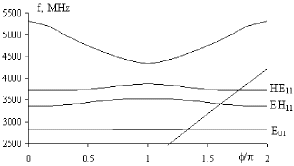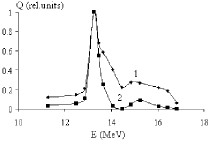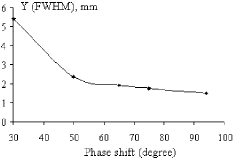Paper is dedicated to description of the operating
performances and current status of the Laser Injector Complex
Facility (LIC). This linac was constructed for investigation of
physics of the high-brightness electron beam forming and acceleration.
The linac consists of a multipurpose RF gun and a novel acceleration
structure. LIC can be operated with microsecond (thermionic emission)
and nanosecond (laser stimulated emission) duration of current
pulse and energy of electrons 13-20 MeV. In thermionic regime
we have obtained electron beam duration 0.5-1 s, beam current
about 1 A and normalized rms emittance about 20 mm mrad. The results
of experimental measurements of beam performances are given..
LIC, ( Linear Injector Complex ), facility was developed and constructed in view of forming and acceleration of high - brightness electron beams. This R&D was to be followed by beam research in the following arias:
- ultra - short wave generation;
- wake-field generation in plasmas and other systems;
- relativistic electron beam focusing in plasmas;
- testing of the diagnostic equipment developed within the framework of the VLEPP program.
The electron energy at the accelerator output was to be 15 to 20 MeV which is sufficient to carry out the above programs. One of the major factors taken into account during development of the facility was limitation of the RF - power (20 - 25 MW) obtainable using the available klystron KIU-12. LIC accelerator complex was commissioned during 2 years ( 1991 - 1992 ). In 1994, the facility was shut down in order to reconstruct the injector and assemble experimental devices in the area of plasma physics. The work was renewed in 1995.
Its basic components are an RF-gun [2,3], the accelerating section, beam steering and its focusing elements, beam diagnostics, cooling water system and control elements. The RF system includes a klystron with the maximum power operation up to 25 MW, a set of waveguides, controllable phase shifter and attenuator.
Having in view the multipurposeness of the facility under development, we brought out the following major criteria which were taken into account while choosing the necessary type of the accelerating structure:
- the feasibility of acceleration of beams with high charge in the stored energy mode at moderate values of RF-power input (P 20 MW);
- reduction of amplitudes of TEM waves which are exited by high-intensity electron beam and lead to emittance enhancement or even to shortening of pulse length (BBU instability);
- the feasibility of intense electron beam
acceleration with small radial dimensions with the minimum number,
or even absence, of external focusing elements.
| Operating mode | 4/3 (2/3) |
| Length (m) | 2.31 |
| Disk hole diameter, 2a (cm) | 5 |
| Disk thickness, t (cm) | 5 |
| Periodic length, D (cm) | 7.145 |
| Attenuation, (1/cm) | 2.44 10-3 |
| Group velocity | 0.01c |
| Freguency, f (MHz) | 2797 |
| Shunt impedance (for fundamental space harmonic amplitude/for synchronous space harmonic amplitude), (Megohms/m) | 31.3/11.3 |
The most attractive was the accelerating structure STRAM-90 (the abbreviation standing for STRucture Accelerating Modified) developed at NSC KIPT which has been designed to accelerate intense short -pulsed electron beams in the stored energy mode at moderate values of RF power input values (P 1520 MW) [4,5]. This structure represents a disk-loaded waveguide with the period being two times higher than that in the disk-loaded waveguide with 2/3 mode. Particle acceleration in such structure is made by the first spatial mode of the electromagnetic wave propagating in the opposite direction to the electron beam. Beside increasing the charge value, which can be accelerated in the stored energy mode, the STRAM-type structure has the RF-focusing owing to the presence of a large non-synchronous spatial mode [6,7].
The period increase also leads to a considerable reduction in the TEM-wave generation, since the particles are synchronous with higher spatial modes of these oscillations.
However, employment of such a structure in the linac under development was hampered by two factors. The first one being in the fact that due to a small shunt impedance at the first spatial mode there was the necessity to make use of the traveling wave resonant ring in order to increase the acceleration gradient. The second one was the structure losing its advantages during transition to the single-bunch acceleration mode [4]. We have developed a new version STRAM-91, producing acceleration at the first spatial mode, but having both an increased value of the accelerating field and a low level of higher mode amplitudes irradiated by particles [4]. This was achieved by making use of unusually thick disks with large values of the coupling hole.
Major parameters of this section, developed and fabricated
at NSC KIPT, are given in Table 1. The dispersion characteristics
measured at a six-cavity assembly are given in Fig.1.

The beam characteristics measurement system consists
of two pulsed beam current monitors, a magnetic particle energy
analyzer, a unit of movable slot collimators, a Al2O3
screen with a TV camera and a multi-sectional Faraday cap. Beam
emittance measurements at the linac exit are performed by the
three gradient technique. A quadruple lens is used for this purpose
together with the particle spatial distribution monitor, placed
at a distance of 2 m from the lens, and consisting of a set
of moving slots 0.3 mm wide. In order to make estimations
of the transverse dimensions a Al2O3 screen
with TV-camera as well as a sectional Faraday cap consisting of
several coaxial ones are employed.
At all stages of the accelerator development calculations were performed both analytically and as computer simulations. In this way, during development of the acceleration section its geometrical dimensions were calculated, as well as basic RF-characteristics for operation at 4/3 mode. Besides, the calculations were done of the particle dynamics in the sections allowing to evaluate the degree of RF- focusing and peculiarities of wake-field generation.
During designing of the gun, in order to optimize its resonators and determine the beam characteristics a set of calculations and simulations (the SUPERFISH and PARMELA codes were used) was performed. In a more detail, the calculation results are given in [3]. From the calculations it follows that the gun can be used successfully both in photo- and thermionic emission modes.
In order to study the particle dynamics in the accelerator using the numeric simulations within the PARMELA code, a model of the entire accelerator was constructed including the RF gun, beam-forming elements and the accelerator section. At first stage we began to study the thermoemission regime with long pulse duration. Preliminary results show that despite of the high injection energy (W01 MeV) there is a strong phase movement of the particles at the initial part of acceleration process. We connect this fact with the smallness of accelerating field amplitude at the entries of our section. Under such conditions a strong phase movement can take place at sufficiently high energy of the injected electrons. Under optimum conditions the length of bunches can be strongly reduced (from 50 at the exit of the RF-gun to 4- 7- at the exit of the accelerating structure).
Very interesting are the results of radial motion.
As it have been mentioned in previous papers [5,6], in the accelerating
structure under consideration there is RF-focusing and at the
accelerator exit we should have converging electron beam. Besides,
we modeled various accelerator operation modes and beam relationship
vs. different parameters in order to compare them with experimental
results.
Experimental studies in the operation mode of forming and acceleration of single picosecond pulses require utilization of very complicated and costly laser system. Over and above, studies on wake-field generation in plasmas in 1995 called for beams of microsecond duration. In this connection, research into accelerator characteristics during the initial stage was done at a microsecond beam current pulse. With this in mind, the gun had been outfitted with a thermionic emission cathode 5 mm in diameter [2]. The RF-tuning provided for the equal field strength in the first and second cavities which is optimum in case of the thermionic emission cathode at field strength inside the cavity of 25 to 30 MV/m.
In stable accelerator operation regimes (pulse repetition rate 6.25 PPS, current pulse duration 2 s, RF-power input ~1.8 MW) the typical current pulse amplitude at the exit was 1.5 - 2.0 A. With an optimum phasing of the acceleration section the output pulsed current was 1- 1.1 A making the capture rate near 70% which is in accordance with the calculated data. Experimentally shown is the possibility of current pulse reduction at the linac exit from 2 to 0.25 s by way of decreasing of RF-power input or increasing of cathode heating. This is accompanied by particle energy decrease at the gun exit due to beam loading, and only the most energetic electrons become involved in the acceleration process.
In the experiments was observed a ramp in pulse current of RF-gun and a drop of field strength in the cavities on account of the electron back bombardment of the cathode surface. This phenomena was studied during the experiments. It was found that at a pulse repetition rate exceeding 6.25 PPS the overall average cathode surface temperature went up above 90 C which called for a decrease of the heating, leading under certain RF-power input conditions to an unstable gun operation.
An analysis of the particle energetic distribution
at the linac exit showed that at a pulsed current ~1 A and
pulse duration 1.4 s the energy spectrum possesses an additional
maximum in the high-energy region. The shape of the energy spectrum
is determined by particle energy coherent losses (beam current
loading). In this way, at I=1.05 A the mean energy
was 13.5 MeV, the width of the integral energy spectrum 7%
(Fig.2-1), while the width of particle spectrum distribution,
as they were injected into the section after ~1 s from the
beginning of the pulse, did not exceed 3% (Fig.2-2).

For the same accelerator operation regime a three
gradients method was used to measure beam emittance. From this
measurements it follows that in the vertical plane the integral
(during the entire pulse) normalized emittance was 26 mmmrad.
During emittance measurements in the vicinity of the temporal
point corresponding to the current maximum (~1 s after the
beginning of the pulse) this value did not exceed 16 mmmrad.

Experimental results show that at the accelerator exit we have converging electron beam. As there is a dependence of beam dimensions on the beam injection phase into the accelerating section (Fig.3), we can make a conclusion that this phenomena is determined RF-focusing.
During the tests after upgrading the beam characteristics were also studied in the photo-emission operation mode. At the first stage, BaNi cathode was used as a photocathode at such a temperature that practically excluded operation in the thermionic emission mode. During cathode irradiation at the wavelength 355 nm the gun produced pulsed current 2 - 2.5 A, with the pulse width 6 - 7 ns. At the accelerator output the pulsed current value was 1.3 - 1.6 A. Beam current measurements were done relative to cathode temperature and field strength in the gun cavity.
At present, an experimental research on wake-field
excitation in plasmas of various density is carried out at the
accelerator. Having this in view, an experimental device was assembled
at the accelerator exit, including a coaxial plasma gun (plasma
density being 1010 - 1016 cm-3)
and a diagnostic set for plasmas and the wake-field. During the
assembly, the problem was solved of in-vacuum separation between
the accelerator part of facility and its plasma-relation
portion. Taking into account the fact that the beam has small
dimensions, an extended collimator was placed at the accelerator
exit (4 cm long, 4 mm in diameter), as well as auxiliary
vacuum pump. Such a set up allowed to maintain the necessary vacuum
condition in accelerator during plasma gun operation. Particle
losses in the collimator do not exceed 10%.
Thus, NSC KIPT has built and put into operation a
multipurpose accelerator facility for R&D purposes. Our simulations
and experimental data allow to state that combination of an RF
gun with the accelerating section operating at the 1-st spatial
harmonic makes it possible to create injector accelerators with
a high beam brightness. The subsequent research on particle dynamics
in the accelerator should be continued in the direction of studies
on the radial dynamics and clearing out the conditions to provide
at the linac exit for intense beam production with the minimum
emittance. Over above viewing to employ LIC as an FEL driver,
we are planing to increase the current pulse duration to 8 - 10 s.
We express our gratitude to the staff of "Accelerator"
R&D Production Establishment of NSC KIPT for their invaluable
help to the experiments. We are indebted to the AOT-1 group of
LANL (USA) for their contribution to our successful work on the
particle dynamics simulations.
[1] M.I. Ayzatsky et al. "High Brightness Electron Linac with RF Gun and Accelerating Structure on Backward Wave", Proc. EPAC96, will be published.
[2] M.I. Ayzatsky et al. "Two-cell RF Gun for a High Brightness Linac", Proc. EPAC96, will be published.
[3] V.A. Kushnir and V.V. Mitrochenko "Simulation of Beam Performances of the Two-cell RF Gun", Proc. EPAC96, will be published.
[4] M.I. Ayzatsky. ZhTF, 1995, Vol. 65, 6, p.153, (in russian).
[5] M.I. Ayzatsky, E.Z. Biller, E.V Bulyak et al. Voprosy attomnoi Nauki i Tekniki, VANT: series, Nuclear Physics Research (Theory and Experiment), 1991, 3(21), pp. 16-18, (in russian)
[6] L.A. Makhnenko, V.L. Parhomov, K.N. Stepanov. ZhTF, 1965, Vol. 35, 4, p.618, (in russian)
[7] M.I. Ayzatsky, E.V Bulyak, V.I. Kurilko. Proc. 12 th AU-Union Seminar on Charged Particle Accelerators, Dubna, 1992, vol. 1, p. 412, (in russian)